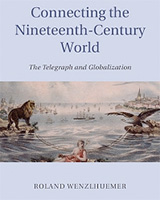When the Telegraph Network First Connected the Continents
6 December 2012

Towards the end of the 19th century, the telegraph network connected all the continents with one another for the first time. How people used the new technology and how it, in turn, changed communication is the subject of a newly released book by Heidelberg historian Dr. Roland Wenzlhuemer. Through numerous examples, such as the emergence of news agencies, the author explains the interrelationships between the spread of the telegraph and globalisation – and the parallels to and differences from the development of the Internet 100 years later. Dr. Wenzlhuemer conducts research in the Cluster of Excellence “Asia and Europe in a Global Context” of Heidelberg University.
In the nine-chapter book, entitled “Connecting the Nineteenth-Century World. The Telegraph and Globalization”, the author takes us through the history of telegraphy in a variety of contexts, such as a means of communication for trade and finance or for news agencies and other media. The researcher points out the significance of the telegraph for society and culture and discusses the spread of the British telegraphy network into India. His publication also includes a comprehensive appendix with statistics and analyses. “The telegraph significantly simplified and accelerated the exchange of information, and thereby the exchange of goods”, says Dr. Wenzlhuemer. Thanks to the telegraph, for example, people knew exactly when steamships would arrive in or depart from a given port. This information was provided to the newly founded news agencies and published in newspapers such as “Lloyd’s Lists”. Using these shipping lists, Dr. Wenzlhuemer was able to analyse the extent to which and how quickly news spread through the worldwide telegraphy network.
The author draws numerous parallels to the development of the Internet at the end of the 20th century. The undersea cables, for instance, were laid and cross-connected in similar fashion at almost all the same locations. “But the telegraph also greatly affected language usage, just as the Internet has”, explains Dr. Wenzlhuemer. He cites an exchange between the Prince of Wales and the King of Portugal in June of 1870: Although the English prince sent an extremely formal official message of thanks to the Portuguese king for his support of the laying of an undersea cable, the latter responded a short time later in cablegram style, casually signing it “LUIZ”.
Assistant Professor Dr. Roland Wenzlhuemer teaches in the Department of History at Heidelberg University and heads a research group of the Cluster of Excellence “Asia and Europe in a Global Context”. In his habilitation thesis, “Transforming Global Spaces: The Telegraph, Communication and Globalization in the Nineteenth and Early Twentieth Century”, he examined the globalisation processes of the 19th and 20th centuries. He was awarded a Heisenberg scholarship by the German Research Foundation.
For more information on the book and a video on the work of Roland Wenzlhuemer, see www.asia-europe.uni-heidelberg.de/de/telegrafie.
Reference:
Roland Wenzlhuemer: Connecting the Nineteenth-Century World. The Telegraph and Globalization. Cambridge University Press 2012.
Note to news desks:
Contact press@asia-europe.uni-heidelberg.de to request a review copy. Roland Wenzlhuemer is also available for interviews.
Contact:
Dr. Alexander Häntzschel
Cluster of Excellence “Asia and Europe in a Global Context”
Phone: (06221) 54-4008
press@asia-europe.uni-heidelberg.de
Communications and Marketing
Press Office, phone (06221) 54-2311
presse@rektorat.uni-heidelberg.de

